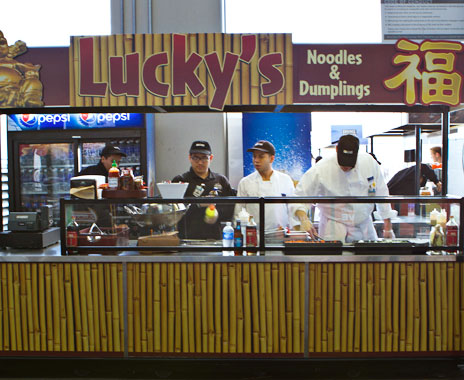With chicken wings, nachos, and pizza at the ready, more than 100 million fans will be piling into homes, restaurants, and bars across the country to watch the Denver Broncos and Seattle Seahawks battle it out in Super Bowl XLVIII.
But at New York City’s MetLife Stadium, home of this year’s Super Bowl, more than 80,000 fans will have a much wider range of foodservice options at their disposal. Though chicken tenders, hot dogs, and pizza used to be the way of life in arenas, stadiums, and other venues, the face of live-event foodservice is quickly changing, thanks to consumers’ increasingly sophisticated tastes, connection to mobile technology, and insistence on a higher-level experience in the stadium at every touch point, foodservice included.
“Because of the downturn in the economy, people are much more cautious or selective … with how they’re spending their entertainment dollars, so stadiums and arenas definitely need to compete on the foodservice level with what consumers are seeing and getting on the streets,” says Steven Brush, a consultant at nontraditional franchise consulting firm iBrandEz. “Hot dogs and hamburgers and french fries are king, but there’s a whole subset now that is looking for a better dining experience.”
Event hospitality company Centerplate, which creates food and beverage programs for nearly 350 global venues, has worked quickly and efficiently to put these insights into action, spending the last year rebranding and studying its consumers to figure out the best ways to deliver an unparalleled in-stadium dining experience.
By segmenting, researching, and understanding the various types of consumers it serves, Centerplate has been able to pinpoint guests’ needs and desires inside a stadium, convention center, or other event space, says Des Hague, CEO of Centerplate.
“The family guy going with his wife and two kids needs value, particularly in this disposable income–distressed economy,” he says. “The socialite wants a splurge event, wants a Super Bowl experience in every venue they go to, so they want high-end foods, they may want cocktails, they may want specialty drinks.”
In addition to customization, incorporating a local touch to the stadium foodservice experience is becoming a consumer demand that companies like Centerplate can no longer ignore. “We don’t just throw a national brand in a sports stadium or a convention center,” Hague says. “We work with a local chef, a restaurateur, and we figure out what is signature in those markets. Then we work with the local suppliers and the farmers in the community, so when people come in for a really nice club or suite experience, they actually see that differentiation.”
While top-selling items like pizza, hot dogs, and hamburgers used to make up 80 percent of Centerplate’s menu—allowing the remaining 20 percent to feature specialty or signature items that spoke to the local community—Hague says the company is now attempting to flip the script, with 80 percent of the menu consisting of innovative items that vary from venue to venue based on local and regional preferences.
“It could be Indian in Vancouver; it could be more Asian based in San Francisco. It’s more vegetable and salad based in Southern California,” he says. “It’s really picking the right items to celebrate with.”
Few companies and stadiums know more about the importance of localization than Delaware North, a hospitality and foodservice company that operates food and beverage programs at MetLife Stadium, among other venues. For the upcoming Super Bowl, the company worked for nearly two years developing a locally relevant menu for guests all over the arena.
“Being that New York is the food capital of the world, it was important that our stadium represented that well,” says Eric Borgia, executive chef at MetLife Stadium.
After embarking on a food tour of the region and discovering the most popular dishes in the area, Borgia’s team brought its research to the kitchen to craft signature dishes that speak authentically to the surrounding community.
Whether it’s the Fulton Seafood Combo—a basket of wild-caught flounder, seared scallops, grilled shrimp, and fried calamari that evokes memories of a day at the Jersey Shore—or noodle bowls and dumplings with ingredients straight from Brooklyn, “there’s a local link to why we’re doing it and where we’re getting it from,” Borgia says.
Though these atypical offerings are the primary focus in the Super Bowl foodservice lineup at MetLife, Borgia has also prepared twists on classic stadium foods like hot dogs. The Kitchen Sink Sandwich, for example, features coin slices of three different types of sausage, topped with fried potatoes, peppers, onions, and a vinegar-based sauce. “It’s almost a play off the Italian hot dog, and we just made it more stadium relevant,” Borgia says.
Although they’re important, personalization and localization aren’t the only trends taking over live-event foodservice. Mobile technology is set to revolutionize the industry, too, with in-seat ordering at the top of many stadiums’ priority list. In its work with the new San Francisco 49ers stadium, Hague says, Centerplate is developing the most sophisticated mobile ordering solutions on the market.
“We expect our guests to be able to sit wherever they are in the stadium and order food that can be picked up or delivered to them. They can order merchandise, they can get game feed, they can look at loyalty programs,” he says. “[The arena] could be the newest of the next wave of stadiums.”
Though Brush says mobile technology will be many event hospitality companies’ main focus moving forward, it’s a change that may take some time to pay off. “It’s a whole departure from the current mode,” he says, adding that the staff training and price involved are sizeable.
“It will be a big hit with the fans and the consumers, but there is a testing piece that’s always expensive,” Brush says. “And then there’s a roll-out phase that obviously has a fair amount of trial and error to it until it’s perfected.”









